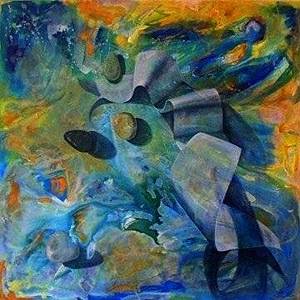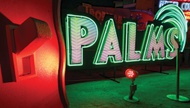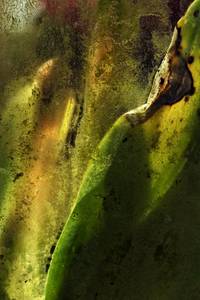More
- David Lancaster Photographs: The Greenhouse
- Lisa Mack Paintings
- Through July 11
- The Water Street Gallery
- 155 S. Water St., Henderson, 253-0800
- The Water Street Gallery
Artists often have obsessions, and the ability to make their obsessions ours, if only for the moment, is a measure of their success. Photographer David Lancaster and painter Lisa Mack have highly idiosyncratic obsessions—his, the “minute details of nature,” hers, a particular shape. And although their peculiarities make their work a little quirky, finding the strange affinity between these dissimilar artists, both exhibiting at the Water Street Gallery in Henderson, helps in understanding their work.
Lancaster’s exhibit features his greenhouse photographs, and an earlier series gives some insight into his working methods and sensibilities. Strolling through Massachusetts’ Great Meadow Wildlife National Refuge, Lancaster came across a large block of ice, the form and refractive surface of which fascinated him. Observing and photographing it over the next several weeks, he was intrigued by small instances of beauty—an embedded leaf or the vivid red petal of a tulip beneath the frozen surface. Similarly, in the greenhouse series, Lancaster records the effects of time and the elements on a Massachusetts college greenhouse—a small corner of the world where years of interior humidity have allowed fungus, dirt and plant material to nearly obscure the windows. Photographed from the outside through wavy vintage glass, these botanical forms are seen as fragmented and abstract. Orchids, which already have an exotic quality, take on an otherworldly aspect. The title of one of these photographs, “Transmundane,” reinforces the perception of a supernatural quality.
In the photo “Greenhouse,” Lancaster has uncharacteristically taken a few steps back to include the window frame within his purview. The same accretions of dirt, fungi and plant material that look abstract in his other photos are seen here in the context of human cultivation and are freighted with meaning that hits closer to home. Aided by the diffused light of a New England fall, this ordinary scene becomes a beautiful yet painful reminder of our own inevitable decay.
While Lancaster focuses his lens through panes of glass to find a transcendent reality, Lisa Mack, in heeding Whistler’s admonition to apply paint like breath on a pane of glass, finds her own way to arrive at the same place. The technique, not the medium, is the message as she overlays thin washes of transparent colors to model forms and creates ambiguous backgrounds. She’s obsessed with things that undulate, curl or spiral—a Nautilus shell, a Calla lily and various configurations of ribbons and paper. She is an acute observer of contours: I particularly enjoyed a painting that depicts a spiraling paper tower, reminiscent of the Guggenheim Museum in New York. Its delicately painted surfaces and hollows tenderly exploit the tension between a solid form and the light perishable material it’s made of. Of her nature paintings, I enjoyed a small work that captures the subtly undulating contour of dry, slender leaves. Scattered on a muted orange and green background that suggests autumn, they refer obliquely to nature’s cycle of life and death.
One painting, “Land and Sea,” has an almost maniacal energy that contrasts with her usual low-key approach. The central object is still her signature ribbon—here painted a lovely pale blue. The ribbon is undulating across the canvas in a frenzy of puckers and waves. A smattering of finely painted pebbles, their surfaces worn smooth by millennia of ocean currents, punctuate the splashes of cerulean and ultramarine. The dynamic radiating composition, painted in shades of yellow and blue (complementary colors that vibrate the optic nerve), hits you with Big Bang force. What makes this painting so powerful is the feeling of instantaneous creation simultaneous with the slow, relentless cycle of decay and regeneration. Through her process of carefully layered washes juxtaposed with incautious splatters of color, dynamic natural forces become visible.
For both Lancaster and Mack, the beauty of nature is a window into truth, however fragmented or incomplete. But to transport a viewer, art must have pity as well as beauty—unfortunately, too much of Lancaster’s work is remote; too much of Mack’s work is precious. But when they can tap the wellspring of pity, Lancaster’s “Greenhouse” makes your spine tingle, and Mack’s “Land and Sea” allows us pitiable creatures to transcend our earthly bounds.
The bottom line: ***






Previous Discussion: